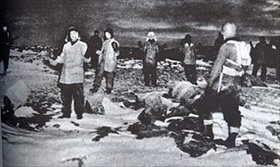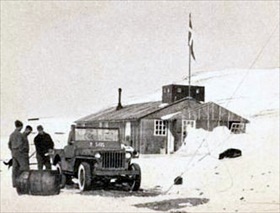FDR SENDS TROOPS TO OCCUPY GREENLAND
Washington, D.C. · April 10, 1941
On April 9, 1941, a full year after Operation Weseruebung had brought Denmark and Norway into Nazi Germany’s orbit, the Danish minister in Washington, D.C., Henrik Kauffmann, signed a treaty with the United States, authorizing the U.S. to protect the remote Danish colony of Greenland “against attack by a non-American power” and to construct military stations on the island for that purpose. The Danish envoy, notable for refusing to recognize the Nazi occupation of his country, was supported in his move by Danish diplomats in the U.S. and by authorities in Greenland, who were keenly aware of the difficulties Denmark faced in governing the island after the outbreak of war. By signing the treaty “in the name of the King,” Kauffmann was in clear violation of his diplomatic powers. (Although it affirmed Greenland’s loyalty to the mother country, the treaty was disavowed by authorities in Copenhagen because it allowed the U.S. to establish bases on Danish territory.) On this date in 1941, a day after the signing ceremony, President Franklin D. Roosevelt played his trump card by declaring Greenland to be part of the Western Hemisphere. This declaration brought Greenland under the provisions of the Monroe Doctrine, which U.S. presidents had used to oppose European interference in the Americas for over a century. The inclusion of Greenland into what the U.S. considered its exclusive playground was all the more important after Germany had made reconnaissance flights over Greenland, causing concern in Washington circles that Adolf Hitler might try to establish bases on the island for future use against the U.S. Greenland’s occupation by American forces on the same day as the announcement was followed two months later by the occupation of the strategically located Danish dependency of Iceland, where U.S. Marines supplemented and eventually replaced British and Canadian service members who had been stationed there since May 10, 1940. The occupation of Greenland and Iceland brought the Roosevelt administration closer to supporting Great Britain in its Battle of the Atlantic. Henceforth, U.S. Navy vessels extended their convoy patrols to these two territories, both lying along the sea lanes linking the U.S. to its future ally against Nazi Germany.
[amazon_carousel widget_type=”ASINList” width=”600″ height=”200″ title=”Recommended Reading” market_place=”US” shuffle_products=”False” show_border=”False” asin=”1439183244,1416591109,1599213222,046501982X,046501397X,0465029612,0547775245,1844153665,0465091563,087081768X” /]
Greenland’s Role in the “Weather War”
 |  |
Left: The Germans set up three secret weather stations on Greenland’s eastern shore to provide them with advance weather information for the dual purpose of assisting their submarine, surface, and air campaign against Allied merchant shipping in the North Atlantic and predicting as much as 72 hours in advance the weather situation in the European theater. (The Germans briefly had one remote weather station set up on the northern tip of Labrador, Newfoundland, on the North American continent.) The Allies used weather data gathered from their own weather stations in Greenland to plan the invasion of Normandy. As poor as this photo is, it depicts members of the German Edelweiss II weather station being taken prisoner by a team of 200 U.S. soldiers, October 4, 1944.
![]()
Right: To show the Allies their willingness to fight the Germans in the Arctic desolation of their homeland, a small band of Danes, Norwegians, and native Greenlanders came together as the North-East Greenland Sledge Patrol in the summer of 1941. The patrol’s activities were to locate and eliminate German radio and weather stations. In March 1943 a dog-team patrol discovered the German weather reporting station Holzauge at Hansa Bay on the northeast coast, where it had been operating since August 1942. In May 1943 U.S. aircraft from Iceland bombed the station. This photo shows the headquarters of the Sledge Patrol in the Northern District at Daneborg/Sandodden, Greenland. Note the Danish flag atop the building.
Various Newsreel Clips from 1944, the First Showing the Destruction of German Radio and Weather Stations in Greenland
![]()

 History buffs, there is good news! The Daily Chronicles of World War II is now available as an ebook for $4.99 on Amazon.com. Containing a year’s worth of dated entries from this website, the ebook brings the story of this tumultuous era to life in a compelling, authoritative, and succinct manner. Featuring inventive navigation aids, the ebook enables readers to instantly move forward or backward by month and date to different dated entries. Simple and elegant! Click
History buffs, there is good news! The Daily Chronicles of World War II is now available as an ebook for $4.99 on Amazon.com. Containing a year’s worth of dated entries from this website, the ebook brings the story of this tumultuous era to life in a compelling, authoritative, and succinct manner. Featuring inventive navigation aids, the ebook enables readers to instantly move forward or backward by month and date to different dated entries. Simple and elegant! Click 











